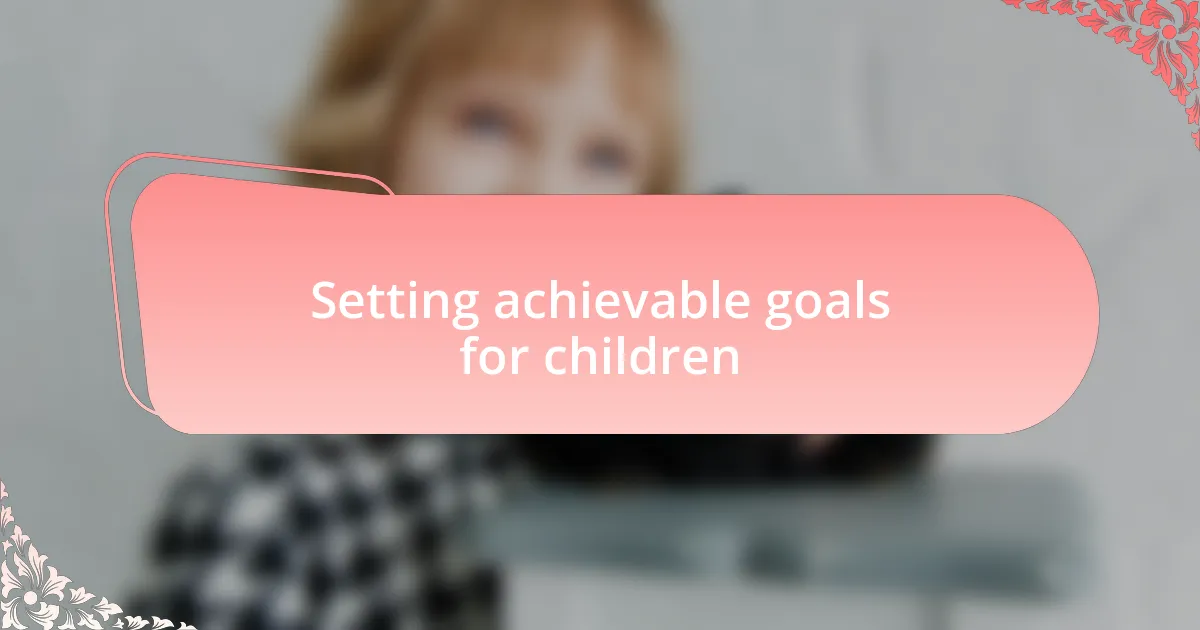Key takeaways:
- Active routines promote children’s physical and emotional health, fostering resilience and social connections.
- Engaging in after-school activities develops life skills and encourages creativity and collaboration.
- Setting specific, achievable goals and celebrating small victories boosts children’s confidence and motivation.
- Flexibility in scheduling and involving children in planning increases ownership and enhances enjoyment of activities.

Child health support overview
Child health support encompasses a range of practices and strategies designed to promote physical and emotional well-being in children. I’ve found that each child is unique, and their needs can vary significantly, which often prompts me to reflect on what specific support my own kids require at different stages of their development. It’s crucial for parents to understand that providing a supportive environment involves consistent communication, nutrition, and physical activity.
When we consider the role of active routines after school, it isn’t simply about keeping kids busy; it’s about fostering their overall health. I vividly remember when my daughter struggled with anxiety after a long school day. Integrating her favorite activities, like dance, into our evening routine made a remarkable difference. This personalization underscored how effective engagement can reduce stress and enhance emotional resilience.
Many parents may wonder, “How can I balance structured activities with downtime?” From my experience, a flexible approach tends to work best. Allowing children to choose between organized sports or creative play can help them feel empowered and excited about being active. Achieving that balance requires a bit of trial and error, but when children feel actively involved in these decisions, it can lead to a more positive outlook on their health and routines.

Importance of active routines
Active routines are vital for children’s physical and mental health, and I’ve seen firsthand how they can transform a child’s mindset. For example, after a challenging day at school, my son would often come home feeling overwhelmed. When we established a routine that included outdoor play, he not only burned off energy but also found relief from his daily stresses. This shift helped him focus better during homework time.
Additionally, the social aspects of active routines can’t be overlooked. Many evenings, my daughter would invite friends over for a game of soccer after school. I realized that these interactions not only fostered teamwork but also built friendships that contributed positively to her emotional well-being. Have you ever noticed your child’s mood lift after spending time with peers? It’s a powerful reminder that activity isn’t just about movement; it’s about connection.
Moreover, having a set active routine provides structure, which can make children feel more secure. I remember when we first implemented a family walk after dinner; it became a time for us to unwind and chat about our day. That simple practice instilled a sense of safety and predictability, helping my kids feel more grounded. Seeing how routine fosters stability, I’m convinced that such practices are essential for overall child health.

Benefits of after-school activities
Engaging in after-school activities offers children a chance to develop important life skills. I recall my son’s experience in a robotics club; it wasn’t just about building machines, but also about learning problem-solving and collaboration. Have you seen how a little creativity can ignite a child’s interest? Watching him figure out how to overcome challenges gave me a glimpse of how these activities foster resilience.
Furthermore, after-school programs promote a sense of belonging and community. I fondly remember when my daughter joined a dance class. It was through that environment that she met individuals from diverse backgrounds, learning to appreciate differences. Isn’t it amazing how shared passions can unite kids? These connections often extend beyond activities, creating a supportive network that can positively impact their mental health.
Additionally, after-school activities contribute to a balanced lifestyle. I’ve observed that my children are less inclined toward screen time and more eager to engage in physical pursuits once sport or arts are part of their routine. How refreshing it is to see them have fun while staying active! This balance not only benefits their physical health but also enhances their concentration and mood, which I find deeply rewarding as a parent.

Types of engaging after-school activities
Participating in team sports is one of the most dynamic after-school activities. I still remember the thrill of my daughter scoring her first goal in soccer practice. The joy on her face was contagious! Team sports not only boost physical fitness but also instill values like teamwork and perseverance. Isn’t it inspiring to witness children grow more confident as they collaborate toward a common goal?
Artistic pursuits, like painting or theatre, can deeply engage a child’s imagination. A few years back, my son joined a local art club, and the change was remarkable. He transitioned from someone hesitant to express himself into a vibrant storyteller through his drawings. Isn’t it fascinating how creativity cultivates self-expression? These activities allow kids to channel their emotions, making them feel seen and heard.
Lastly, science and technology clubs can ignite a passion for learning in subjects that are often daunting. I was amazed when my daughter brought home a simple robot she built with her peers. Seeing her excitement while explaining how it worked was a powerful reminder of how hands-on learning can spark curiosity. How often do we underestimate a child’s natural ability to innovate? These clubs not only enhance critical thinking skills but also encourage lifelong learning habits.

Setting achievable goals for children
Setting achievable goals for children involves breaking down larger objectives into smaller, manageable steps. I remember when my son wanted to improve his reading skills; we set a goal of reading one book a month together. Not only did this approach make it less overwhelming for him, but it also fostered a sense of accomplishment with each finished book. Isn’t it amazing how small victories can build a child’s confidence?
It’s essential to make these goals specific and measurable. For instance, instead of simply saying, “I want to be better at math,” I encouraged my daughter to aim for completing five math problems each week. By clarifying what “better” meant, she could clearly see her progress, which kept her motivated. Who wouldn’t feel proud seeing tangible evidence of their efforts?
Celebrating achievements, no matter how small, is crucial in this process. When my daughter mastered her math problems, we made her favorite dessert as a reward. It turned those achievements into shared moments of joy and encouragement. How pivotal do you think these celebrations are in reinforcing a child’s efforts? I firmly believe they create a rhythm of positivity that fosters ongoing motivation and enthusiasm toward future goals.

Tips for creating a schedule
When it comes to creating a schedule, I find that flexibility is key. I remember a few months ago, I structured after-school activities so tightly that my son felt overwhelmed. A simple shift to allow for some downtime made a world of difference. It brings to mind the saying, “Life is what happens when you’re busy making plans.” Isn’t it true that allowing space for spontaneity can lead to the most memorable moments?
Including family input in the scheduling process can also inspire ownership and enthusiasm. I once sat down with my kids to brainstorm ideas for activities we could all enjoy together after school. They suggested everything from gardening to nature walks, which turned our routine into something everyone looked forward to. Have you ever experienced how a little collaboration can transform a mundane routine into something special? I truly believe it deepens connections and enhances the joy of shared experiences.
Lastly, consider setting a consistent time for homework and play. My daughter thrives on routine, so we established a designated period right after school for her to complete assignments. This structure not only helped her focus but also created a clear boundary between work and relaxation. How do your children react to having a predictable schedule? I’ve discovered that when they know what to expect, they can manage their time better and ultimately feel less stressed.

Encouraging consistency in routines
Consistency in routines can truly be a game changer. I learned this firsthand when I noticed that my youngest was struggling with anxiety during after-school hours. We started setting aside the same time each day for a calming activity, like reading or drawing, and soon it became something he genuinely looked forward to. Isn’t it fascinating how something so simple can build a sense of security in a child?
Another approach I’ve found effective is to establish a visual schedule. A few months back, we created a colorful chart that outlined our after-school activities. It was amazing to see how my kids would check it every day, eagerly anticipating what was next. Have you ever tried incorporating visuals? It’s as if the routine became more tangible for them, making it easier to follow consistently.
One vital aspect of maintaining routine is celebrating small successes. I remember the thrill my daughter felt when she completed a week of consistent after-school activities without needing reminders. We celebrated with a small treat, reinforcing the positive behavior. Isn’t it wonderful to acknowledge progress? I believe that these little moments of recognition not only motivate children but also create a joyful atmosphere around their routines.